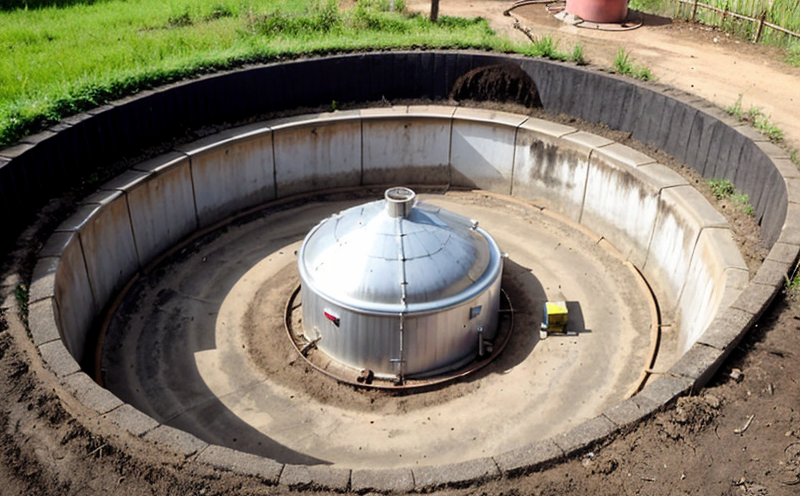Biogas digester inspection
The inspection of biogas digesters is a critical process in ensuring the efficient and safe operation of these systems. Biogas digesters are essential components in renewable energy production, particularly in agricultural and municipal waste management facilities. These systems convert organic materials into biogas through anaerobic digestion, producing both methane and carbon dioxide as primary products. The integrity of the digester is paramount to prevent leaks that could lead to greenhouse gas emissions or operational inefficiencies.
Our laboratory specializes in comprehensive inspections using cutting-edge technology and methodologies that adhere to international standards such as ISO 15268-1 and EN 15703, which are specifically designed for the inspection of biogas plants. This includes detailed assessments of structural integrity, operational efficiency, and compliance with relevant regulations.
The inspection process typically involves several key stages: pre-inspection surveys, visual inspections, non-destructive testing (NDT), and documentation. Pre-inspection surveys include a review of historical records, risk assessments, and identification of potential hazards. Visual inspections are conducted to identify any visible signs of damage or wear that could indicate structural issues.
Non-destructive testing methods such as ultrasonic testing (UT) and magnetic particle inspection (MPI) are used to evaluate the internal integrity of the digester walls without causing damage. These tests help detect cracks, corrosion, and other defects that may not be visible during a visual inspection. The results from these tests are meticulously documented and compared against established standards to ensure compliance.
Once the inspection is complete, our team provides detailed reports outlining all findings, recommendations for corrective actions, and any necessary maintenance or repairs. These reports serve as valuable tools for facility managers in making informed decisions about the ongoing care of their biogas digesters. By adhering to these rigorous inspection protocols, we ensure that facilities can continue to operate efficiently while minimizing environmental impact.
Understanding the importance of biogas digester inspections extends beyond mere compliance; it also contributes significantly to sustainability efforts. Properly maintained digesters contribute to reducing methane emissions and enhancing overall energy efficiency within agricultural and municipal sectors. This service plays a crucial role in supporting global initiatives aimed at combating climate change through sustainable practices.
Scope and Methodology
The scope of our biogas digester inspection service encompasses various aspects to ensure comprehensive evaluation and thorough documentation. The methodology we employ adheres strictly to international standards ensuring reliability and accuracy in our findings.
| Aspect | Description |
|---|---|
| Pre-inspection Surveys | Involves reviewing historical records, conducting risk assessments, identifying potential hazards, and preparing for the inspection process. |
| Visual Inspections | A detailed examination of visible signs of damage or wear to identify structural issues that may require attention. |
| Non-Destructive Testing (NDT) | Utilizing advanced techniques like ultrasonic testing and magnetic particle inspection to evaluate internal integrity without causing harm. |
| Documentation | Meticulous record-keeping of all findings, recommendations for corrective actions, and necessary maintenance or repairs. |
The use of NDT methods allows us to identify potential weaknesses in the digester that might not be apparent through visual inspections alone. This multi-faceted approach ensures a thorough assessment of both visible and hidden defects, providing facilities with accurate information about their current state of operation.
Our team utilizes specialized equipment tailored for this type of inspection, including advanced imaging systems capable of detecting minute flaws within the structure. These tools enable precise measurements and detailed visualizations that enhance our understanding of the condition of each digester inspected. The combination of expert knowledge, state-of-the-art technology, and adherence to international standards guarantees high-quality inspections that meet or exceed regulatory requirements.
Benefits
The benefits derived from regular biogas digester inspections are numerous and far-reaching. Regular inspections not only help maintain the efficiency of your facility but also contribute significantly towards environmental sustainability efforts. By identifying potential issues early on, you can avoid costly repairs down the line and ensure continuous optimal performance.
One major benefit is prevention of leaks which would otherwise release methane into the atmosphere—a potent greenhouse gas contributing to global warming. Methane emissions from improperly maintained digesters pose significant risks both environmentally and economically. Preventing these leaks through timely inspections helps mitigate this risk, promoting healthier ecosystems while reducing operational costs associated with waste management.
Another key advantage lies in extending the lifespan of your biogas digester by detecting and addressing early signs of wear or damage before they escalate into more severe problems requiring extensive repairs or replacements. This proactive approach saves money on costly maintenance projects while ensuring uninterrupted production schedules.
In addition to these environmental and financial advantages, regular inspections foster compliance with local regulations and industry best practices. Adhering to established standards such as ISO 15268-1 ensures that your facility operates within legal boundaries and maintains its reputation for reliability and safety. Compliance also opens doors to additional opportunities like grants or incentives aimed at supporting sustainable initiatives.
Moreover, by maintaining high standards of operation through regular inspections, you demonstrate a commitment to responsible stewardship towards natural resources. This positive image enhances stakeholder trust and confidence in your organization’s dedication to sustainability goals. It underscores the importance of investing time and resources into proper maintenance practices that benefit both present operations and future generations.





